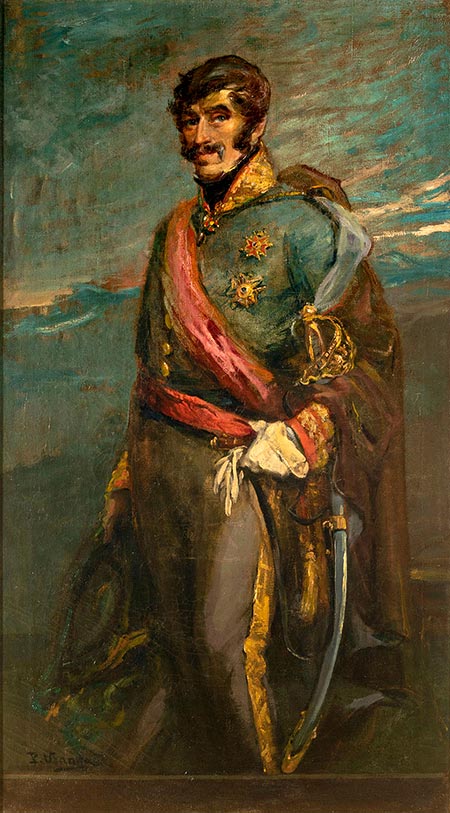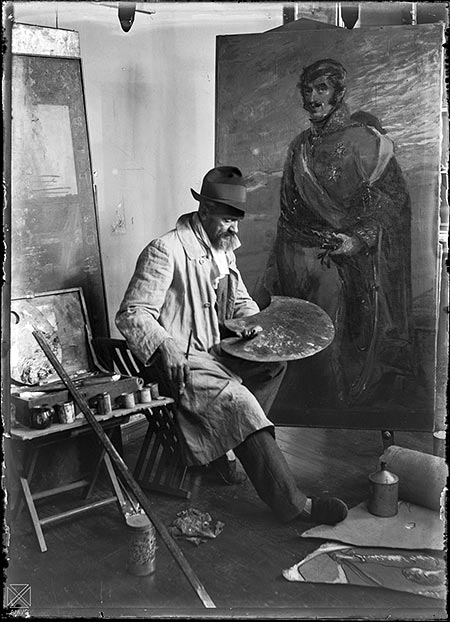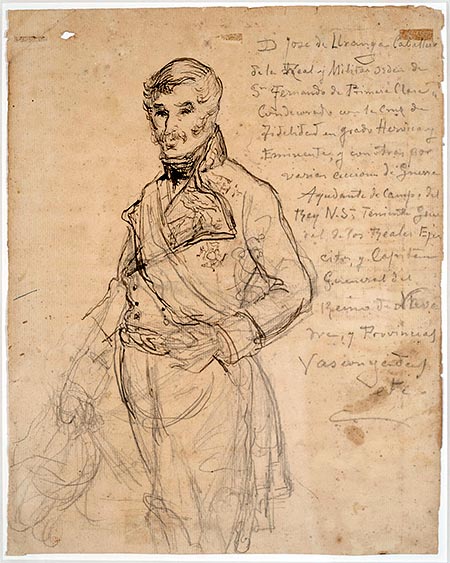The piece of the month of December 2022
PORTRAIT OF GENERAL JOSÉ IGNACIO URANGA, BY THE PAINTER PABLO URANGA, AT THE CARLIST MUSEUM
Iñaki Urricelqui and Silvia Lizarraga
Carlism Museum
It has been part of the permanent collection of the Museo del Carlismo since 2021, when it was donated along with other cultural assets by Elena Uranga, the painter's granddaughter. This study provides information about the portrait, the work and the sources used for its execution.

Pablo Uranga, "Portrait of General José Ignacio Uranga", ca. 1907.
Museum of Carlism.
José Ignacio Uranga Azcune (Azpetitia, 1788-Vitoria, 1870)
He was a Carlist general close to Carlos María Isidro. Degree He began his military degree program during the War of Independence (1808-1814), reaching the rank of second lieutenant in 1813. In 1821 he spoke out against the constitutional government of the Liberal Triennium (1820-1823) and rose meteorically in the royalist army. In 1830 he confronted Espoz y Mina and Jáuregui in their invasion to restore a constitutional government, achieving the Cross of San Fernando for this action.
In October 1833 he rose up in Salvatierra in the name of "Carlos V". He was the organizer of the Carlist army in Alava and presided over its board Gubernativa. A staunch traditionalist, belonging to the "Apostolic" side, he was an extremely Catholic man, faithful defender of legitimacy. He exercised the position of teaching assistant of field of Don Carlos and was part of his board Supreme Consultative. He did not waver in his convictions even when in 1834 his wife, Josefa Antonia de Aguirre, and one of his sons were captured and remained in Vitoria prison for fourteen months.
In 1837 he was named lieutenant general and captain general of Navarre and the Basque Provinces, the highest authority in the north, while the pretender headed the Royal Expedition. In this year, the most important of his military and political life, took place his most recognized actions and criticized by his detractors: the taking of Lerín (May), the confrontation with Espartero in Lecumberri (June), the sending of the expedition of General Zaratiegui to Castilla (July), the taking of Peñacerrada (August), the victory of Andoain over O'Donnell (September), the taking of Peralta (September) and the action of the fort of Perdón (October).
Don Carlos, upon returning from the Royal Expedition, withdrew his command of the north due to the confrontation with the Royal Government of Navarre board , which did not look favorably on the reforms of his mandate. His pundonor led him to stop the wastefulness, imposing good sense in the administration and making him unpopular in his own camp.
Unlike Maroto, in 1839 he went into exile in France, where he remained in emigration for eight years, seven months, ten and seven days. In 1848 he took advantage of an amnesty that allowed him to recover the position of lieutenant general of the Elizabethan army, stationed in Vitoria until his retirement in 1863.
Lieutenant General Uranga considered himself a man of honor. That merit was his only patrimony in exile and the bequest he wished to provide to his children, and he did not accept in life that his actions were judged with demerit by his co-religionists. As did other military men of his time, he defended his actions during the war in his writings, which come to us through his teaching assistant de campo Felipe Camarero Núñez.
Portrait of General Uranga, by Pablo Uranga (Vitoria, 1861-San Sebastián, 1934)
The date of creation is around 1907, a period in which Uranga was settled in Vitoria, after his trip to Jerez de la Frontera, Madrid and Paris, where he stayed between 1889 and 1897, immersed in the bohemian life together with Paco Durrio, and when his painting became more expressive, luminous and colorful. Upon his return, he was closely related to the artistic environment of Bilbao, participating in the Modern Art Exhibitions held between 1900 and 1910, and joining the association of Basque Artists. In 1906, the Marquis of Olaso commissioned him to paint the triptych "The Wedding of Peace" for his residency program of San Salvador del Valle, a historical canvas that won him a silver medal in 1908 at the exhibition Hispano-French in Zaragoza. This work can be considered as the moment in which Uranga felt more attracted to history painting, the context in which the portrait in question was painted. It should also be taken into account the "romantic memory" of his grandfather and his youthful flirtations with Carlism, according to Pablo Uranga Lejarreta, the painter's son, which is collected by Flores Kaperotxipi.
In a format of 180x100 cm, the portrait is standing, in slightly more than three quarters, slightly tilted to the right. He wears a coat with golden fringes on the high collar and cuffs, golden buttons, red cross-band and sash, pinned with the Grand Cross of San Fernando, the Cross of Military Loyalty, and the medal of the battle of San Marcial, pants with golden fringe and a cape on the shoulder. The left hand, gloved, rests on the sash, leaving visible with the gesture of the arm the hilt and the scabbard of the saber, as well as the golden tassels of the sash. With the right hand he holds what appears to be a tricorn. He is represented as lieutenant general of the Army, employment maximum that he reached in 1837 and that was revalidated in 1848.
Chromatically, greenish, bluish and brownish tones predominate, highlighting the white grade of the gloves, the gold of the details of the clothing and insignia, and the red of the sash and sash. The bursts of light in the background landscape add a certain drama to the whole. The brushstroke is looser and more expressive than in other contemporary portraits subject , with a more lively and unfinished style, in the opinion of Arregui Barandiarán, "using color as a gradation element and bringing us closer to the figure in the foreground". A photograph by Enrique Guinea kept in the file Municipal de Vitoria-Gasteiz sample of the artist in the process of executing the canvas.

Enrique Guinea, "Pablo Uranga painting the portrait of his grandfather, the Carlist General José Ignacio Uranga", ca. 1907. file Municipal of Vitoria-Gasteiz.
The general's son, José Blas, made a pencil drawing (col. particular) that may have been useful to his father, although he used more clearly published engravings for its elaboration. We know of at least three. The first is by Isidoro Magués, included in Don Carlos e i suoi difensori (Firenze, V. Batelli e Figli, 1837), which in turn is included in Galería militar contemporánea ( Madrid, Sociedad tipográfica de Hortelano y Compañía, 1846) engraved by F. Pérez. The second is the work of Zarza y Gaspar and appears in Panorama Español. Crónica contemporánea (t. I. Madrid, Imprenta del Panorama Español, 1842-1845), together with the portraits of Valdespina, Echeverría and La Torre. Finally, the third is due to Casado and S. González in the work directed by Pedro Chamorro y Baquerizo, Estado Mayor del Ejército Español: descripción histórica y biográfica acompañada de retratos de los Oficiales Generales que constituyen el cuadro de library assistant (t. II. Madrid, Imprenta Tomás Fontanet y Ruano, 1850-1854). The first and second portraits are the most similar to Uranga's portrait, younger in appearance and characterized by his prominent mustache and sideburns, which can already be seen in the preparatory sketch, in ink and pencil, where the final composition is outlined, with the exception of some variations, such as the coat open at the breastplate or not including the cape. For its elaboration, Uranga used personal objects of his grandfather, such as the coat, the pants, the saber, the gala sash, the medals and the tricorn. Another pictorial portrait is known, owned by the Núñez Astrain family, although unrelated to this one.

José Blas Uranga, "Portrait of his father", ca. 1844; Isidoro Magués, "Portrait of General Uranga", 1837; Zarza-Gaspar, "Portraits of Generals Valdespina, Echeverría, La Torre and Uranga", 1842-1845. Museum of Carlism.

Pablo Uranga, "Sketch of the portrait of General José Ignacio Uranga", ca. 1907. Museum of Carlism.
According to Heraldo Alavés ("Sociedad. Cuadros de Uranga", 3-5-1910), the portrait was exhibited in May 1910 in the showcases of Armentia's successors before being sent to the exhibition International Centennial of Buenos Aires, information that should be qualified, because although his participation in it is noted, the artist does not appear in the Catalog of the sample. Years later, the portrait appeared in the exhibition organized in 1916 in the Ateneo de Vitoria in the framework of the Third Workers' Competition and exhibition Artistic, Industrial and Agricultural and of teaching. Although Julio Ochoa does not mention him in his chronicle in La Libertad ("Visiting the contest. In the Real Ateneo. Conclusion", 25-VIII-1916), a snapshot by Enrique Guinea (file Municipal de Vitoria-Gasteiz) of one of the rooms testifies to this. In 1949 it was part of the exhibition organized as a tribute to the artist at the conference room Aranaz Darrás, San Sebastian, according to La Gaviota, a magazine published by the association Artística de Guipúzcoa.
Although Luis Madariaga does not mention the painting among the outstanding paintings owned by the family, it is known that it was one of the most valued by the artist. In 1930, Juan de la Encina considered it to be the one that best represented the artist with a view to its possible acquisition by the Museum of Modern Art in Madrid, which he then directed. Uranga himself had it among his favorites, as did his descendants, who considered it part of their family heritage.
SOURCES AND BIBLIOGRAPHY
file Diocese of Vitoria-Gasteiz. Death certificate.
Documentation Center of the Museum of Carlism. Uranga Fund:
-
Brief biography of José Blas de Uranga. CD. doc.22.
-
Service Sheet. FOR ESP 028/09.
-
Inventory of assets. FOR ES 028/13.
José Ignacio Uranga
BULLÓN DE MENDOZA GÓMEZ DE VALUGERA, A. "José Ignacio Uranga Azcune", in Real Academia de la Historia, Diccionario Biográfico electrónico (at network).
CAMARERO NÚÑEZ, F., Suplemento histórico o episodio nacional para servir de continuación a las memorias sobre la guerra de Navarra y Provincias Vascongadas, del vizconde de Barrés du Molard, coronel de Estado Mayor del Ejército carlista, o sea, simple rectificación que el teniente general don José de Uranga, nombrado capitán general de aquel Reino y provincias, mandó en jefe el Ejército Vasco-Navarro; precedido de una carta del mismo general al mariscal de campo D. Juan Antonio Zaratiegui, Nantes, Carlos Gailmard Printing House, 1846.
CAMARERO NÚÑEZ, F., Diario del Teniente General Don José Ignacio de Uranga, San Sebastián, Diputación de Guipúzcoa, 1959.
CHAMORRO BAQUERIZO, P., Estado Mayor General del Ejército Español, Madrid, R. Santacana, 1852, pp. 341-344.
OTAEGUI ARIZMENDI, A. and CASTELLS OLIVÁN, I., "The liberal Gaspar de Jáuregui and the Carlist José Ignacio de Uranga. Two parallel lives and a common destiny (1808-1844)", in Profesor Nazario González: una historia abierta, 1998, pp. 286-297.
Pablo Uranga
ARREGUI BARANDIARÁN, A. and LAMARAIN CENITAGOYA, I., Pablo Uranga. El bohemio de Elgeta, Catalog de exhibition. Vitoria, Museo de Bellas Artes de Álava, 2012.
COLA Y GOITI, J., "Workers' competition in Vitoria. Installation of the Corazonistas", Euskal Erria. Revista Vascongada, t. LXXV, 1916, pp. 210-213.
exhibition Buenos Aires Centennial International Art Exhibition 1910. Catalog. Buenos Aires, Est. Gráfico M. Rodríguez Giles.
FLORES KAPEROTXIPI, M., Basque Art, Buenos Aires, publishing house Vasca Ekin, 1954.
FLORES KAPEROTXIPI, M., Pablo Uranga. Life, work and anecdotes of the painter Pablo Uranga, San Sebastian, Itxaropena, 1963.
"Homage to the 'Bohemian of Elgueta'. La exhibition de Pablo Uranga", La Gaviota, association Artística de Guipúzcoa, 32, 1949.
MADARIAGA, L., Basque Painters, vol. II, San Sebastian, Auñamendi, 1970.
OCHOA, J., "Two Vittorianos. Pablo Uranga and Jesús L. de Apellaniz", La Libertad, 10-12-1934.
